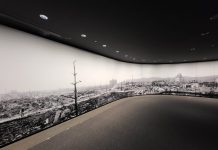Fung Kit-chun is one of the villagers who decided to move to the new village, which is about a 15 minute drive away from the original one. But she did so with a heavy heart.
“In the first few months after I moved here, I did not return to the old village, I was afraid that I could not control my temper,” says 51-year-old Fung.
The old family house, now demolished, meant a lot to her. Her widowed mother had worked hard on the land and raised livestock so she could build that house and to raise her three children. After her mother passed away, Fung still felt connected to her through the house and her grave.
“It was only a 15-minute walk to go to my parents’ graves. Although they were gone, I still felt close to them,” says Fung. “I eventually understood the importance of keeping our roots.”
The villagers’ determination to resist the eviction and devotion to their homeland brought them admirers in some quarters and critics in others. Their critics regarded them as stubborn, stick-in-the-mud types or thought they were just greedily hanging on so they could demand large sums in compensation.
Fung Yu-chuk stresses that compensation was never what the villagers wanted. “We asked the government not to demolish our homes from the very beginning. We did not want their compensation,” says Fung. “It’s actually a hardship for villagers to spend years rebuilding their homes. It causes suffering which is overlooked by outsiders.”
Mrs Tsang, who does not want to give her full name, moved to the old Choi Yuen Village as a young bride. Her determination to protect her home of 45 years drove her to take part in the demonstrations against the demolition of the village. “I had never been to places like the Government headquarters and the Legislative Council,” says Tsang. “But to save our homes, I had to go even at my age; there were no other methods.”
Despite their opposition, the Legislative Council’s approval of funding for the railway project in January 2010 meant the writing was on the wall. Villagers accepted the compensation plan offered by the government on the condition that the government would help them to reestablish a new agricultural community under the Agricultural Land Rehabilitation Scheme.
Building a new village does not simply mean moving households to a new site with new homes. It involves numerous processes, each of which can take months. There are tasks like applying for farming licenses and looking for land to build on and to farm. After 10 months hunting, villagers spent HK$18 million of their compensation money to purchase 145,000 square feet (1.3 hectares) in Yuen Kong San Tsuen in December 2010.
Initially, 89 out of 150 affected families agreed to take part in the reconstruction. But as a result of delays and red-tape, only 47 households persevered and will move to the new village.
The construction work had been expected to start early this year, but unresolved problems like time-consuming procedures to get approval for construction and a poor sewage disposal system, means the date keeps getting pushed back.
Building has yet to start and villagers are still living in temporary prefabricated houses in the new Choi Yuen Village built by the MTRC.






































